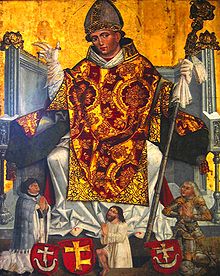Stanislaus of Cracow

Stanislaus von Krakau , German also Stanislaus von Szczepanów, also Szczepański and Rurykowicz , as well as Polish Stanisław ze Szczepanowa or Stanisław Szczepanowski (* around 1030 in Szczepanów ; † April 11, 1079 in Kraków ), was Bishop of Kraków in Poland and is considered one of the Polish national saint.
Life
He came from a Polish nobility family and visited several cathedral schools in Gniezno , Cracow and Paris or Liege . In 1062 he came to Krakow, where he became canon in 1063 . In 1072 he was appointed Bishop of Krakow.
In the spring of 1079, the Polish King Bolesław II was so angry that he was sentenced to death because of a provocation by Bishop Stanisław that has not been recorded. Whether he had him executed or executed himself cannot be proven from contemporary sources.
About a century after this incident, the bishop and historian Wincenty Kadłubek reports in more detail in his Chronica Polonorum and paints the following picture:
Stanisław would have admonished the Polish king Bolesław II for his infidelity towards his wife, but the king would have ignored the request and confiscated church property. Stanisław then excommunicated him . The dispute escalated and Bolesław II passed the death sentence on the bishop. The knights had refused to execute it and the king then carried it out personally. On April 11, 1079, Bolesław II appeared during mass in the Michaeliskirche Kraków and killed the bishop at the altar with the sword and dismembered. He had the body parts scattered in the open field.
Again it is certain that there was a popular uprising because of the execution and that Bolesław II fled to Hungary , later to Ossiach , where he was buried near the collegiate church.

Investigations of the relics showed that the bishop's body was not mutilated, but it was most likely killed. Evidence for this are bone fractures on Stanisław's skull.
Stanisław was canonized by Pope Innocent IV in 1253 . In 1979 Pope John Paul II commemorated the feast of St. John with his Apostolic Letter “Rutilans Agmen” . Stanislaus (April 11th) raised to a bid.
Remembrance day
- Catholic: April 11th ( Obligatory Day of Remembrance in the General Roman Calendar )
- Remembrance day III class: May 7th
- in Poland : May 8th (anniversary of death)
- in Gniezno: transfer of the bones on September 27th
A weather rule applies in Bavaria :
- "When St. Stanislaus approaches, roll out the potatoes ".
Legends
During the Battle of Tannenberg in 1410, St. Stanisław is said to have hovered over the Polish-Lithuanian army and thus led the warriors to victory over the Teutonic Order .
See also
literature
- Wojciech Iwanczak: Stanislaus the Saint. In: Biographisch-Bibliographisches Kirchenlexikon (BBKL). Volume 10, Bautz, Herzberg 1995, ISBN 3-88309-062-X , Sp. 1161-1165.
- Eduard Mühle : The Piasts. Poland in the Middle Ages. Verlag CH Beck oHG, Munich 2011, ISBN 9783406611377
Web links
- Publications about Stanislaus von Krakau at Litdok East Central Europe / Herder Institute (Marburg)
- Rutilans Agmen - Apostolic Exhortation of John Paul II (Latin, 1979)
- Rutilan's Agmen - Apostolic Exhortation of John Paul II (English, 1979)
- heiligenlexikon.de Entry on Stanislaus of Krakow (last accessed on April 11, 2017)
Individual evidence
- ↑ Yahoo! Groups. Retrieved May 19, 2017 .
- ↑ cf. E. Mühle: The Piasts p. 36
- ↑ cf. E. Mühle: The Piasts ibid
| predecessor | Office | successor |
|---|---|---|
| Lambert II. Suła |
Bishop of Cracow 1072-1079 |
Lambert III. |
| personal data | |
|---|---|
| SURNAME | Stanislaus of Cracow |
| ALTERNATIVE NAMES | Stanislaus of Szczepanów |
| BRIEF DESCRIPTION | bishop |
| DATE OF BIRTH | around 1030 |
| PLACE OF BIRTH | Szczepanów near Cracow |
| DATE OF DEATH | April 11, 1079 |
| Place of death | Krakow |